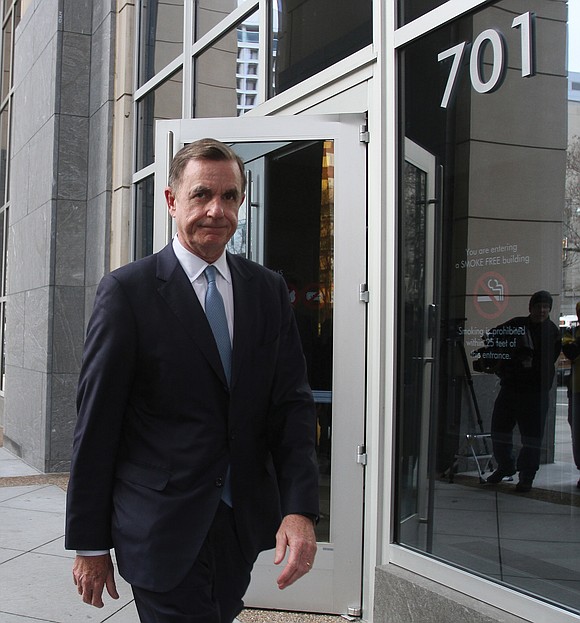Mayor, Navy Hill officials try to sweeten the pot for $1.5B Coliseum plan approval
Jeremy M. Lazarus | 1/17/2020, 6 a.m.
Can a series of revisions save the massive $1.5 billion Coliseum replacement and Downtown redevelopment plan that for months has appeared to be headed for rejection by Richmond City Council?
That’s the hope for Mayor Levar M. Stoney and Thomas F. Farrell II, the top executive at Dominion Energy who is spearheading the proposal through the Navy Hill District Corp.
With only about six weeks left before the proposal is scheduled for a vote by City Council and apparently short of the seven votes needed for approval, the two men Monday served up changes they hope will make the project more palatable to council members who currently seem committed to rejecting the plan as a council-appointed advisory commission has recommended.
One of the biggest changes, according to Mayor Stoney, is the potential for a larger infusion of state sales tax dollars into the project, reducing the amount of city tax dollars that might be needed to cover the cost of building the state’s largest arena to replace the Richmond Coliseum.
The mayor cited a bill introduced in the General Assembly by Richmond Delegate Jeff Bourne that would allow the city to capture part of the state sales tax generated by the project — a deal that the legislature previously granted on arena projects for Norfolk and Virginia Beach.
Those who are bullish on the project and see it generating big taxable revenues at the 30 restaurants and retail stores that are proposed are suggesting the Bourne bill could generate $60 million to $70 million in additional revenue over 30 years.
According to Mayor Stoney, that would allow the city to reduce by half the Downtown Tax Increment Finance District where growth in real estate taxes would be earmarked to repay the money to be borrowed to build the arena.
The cost of the arena is projected to run between $570 million and $620 million, depending on the interest rate and number of years it takes to pay off the debt.
However, the mayor could offer few details of what impact the Bourne bill would actually have. He indicated that he would seek to amend the ordinances now before City Council once more informa- tion is available.
Under the current plan, the Coliseum debt is to repaid by taking the real estate tax growth from the 10-block development area near City Hall and from an additional 70 blocks of Downtown, including the Dominion Energy’s new office tower and a second that is planned. The company has not yet committed to building the second tower.
Others are more skeptical. Paul Goldman, leader of the Put Schools First campaign, noted the estimate of sales tax collections from the TIF District are based on rosy projections that might not materialize.
“You can make up any numbers you want when you are talking about 20 to 30 years in the future,” Mr. Goldman said.
“How could you trust the numbers?” John Gerner, who served as vice chairman of the disbanded Navy Hill Development Advisory Commission that recommended City Council reject the project, urged caution, given that the state has yet to issue an estimate of the amount of sales tax that could be diverted and because the General Assembly bill has not yet been approved.
Meanwhile, in another revision, Mr. Farrell noted that Navy Hill is planning to increase the number of apartments in the project that would be rated as affordable for people with incomes 40 percent to 60 percent of the regional median.
Currently, the Navy Hill proposals includes 280 “affordable” housing units, along with at least 1,818 market-rate units.
He said that Navy Hill, working with the Better Housing Coalition, has identified two opportunities to increase the number of affordable units. He said, as a result, the Navy Hill proposal would meet City Council’s requirement that at least 15 percent of the units be rated affordable.
In a third revision, Mayor Stoney said that Navy Hill and GRTC are studying two options for the location of a proposed GRTC transfer center — the initially proposed site at 9th and Clay streets and a site on Broad Street.
“We want GRTC to have the opportunity to kick the tires on these options and advise us on what works best for GRTC and our residents,” Mayor Stoney said.
Finally, the mayor and Mr. Farrell announced that a fast-growing real estate data firm, CoStar Group, which came to Richmond two years ago and employs about 1,000 people in its city office, wants to relocate its operations to a proposed office building in the Navy Hill development.
Andrew Florance, CoStar founder and chief executive officer, said the planned office building would be ideal as the company makes plans to add an additional 1,000 employees in Richmond.
“The Navy Hill development delivers everything a company like CoStar is looking for — access to transit, entertainment, conferencing and new multi-family residential housing, all in a walkable and vibrant neighborhood,” he said.
“Without the Navy Hill development as a complete-package option, we would not be talking about significantly expanding our commitment to Richmond. Richmond has so much to offer, which is why we would like to keep growing with it, providing competitive careers and compensation for residents in the process,” he said.
Mr. Farrell hopes City Council members would want CoStar’s development to happen.
“With City Council approval, we can revitalize our Downtown, improve economic opportunity,” he said, “and make Richmond the place for innovative companies and their employees to grow, thrive and live.”
Mr. Farrell said he and the rest of the Navy Hill group “look forward to continuing our work with the council to deliver the best project for the city, taxpayers and residents.”







